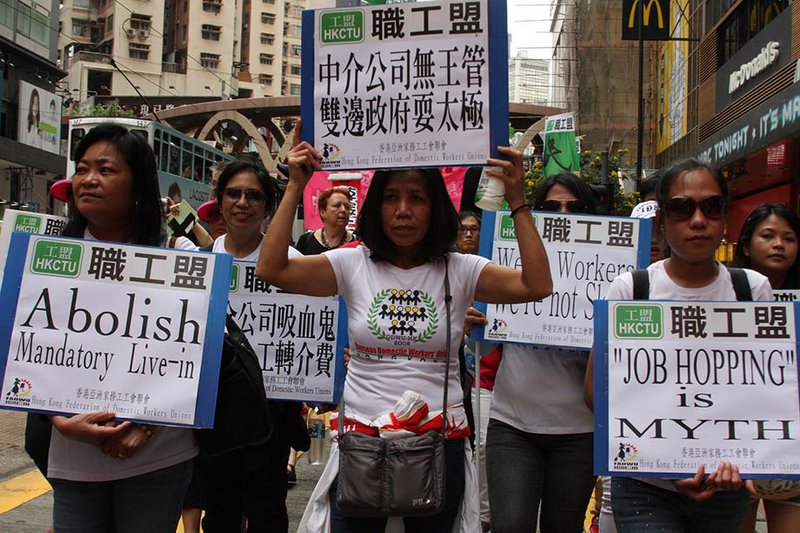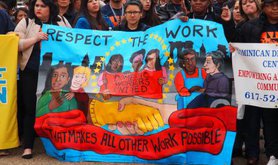
Domestic Workers in Hong Kong ask for changes on the International Workers' Day. IDWF/Flickr. (CC 2.0 by-nc-nd)
It is commonly understood in debates on trafficking or forced labour that the illegality and irregularity of domestic work, plus the absence of regulation, is what generates the vulnerability to exploitation characterising life for workers in this sector. In their contribution to Beyond Trafficking and Slavery, Anna Triandafyllidou and Sabrina Marchetti argue that “unintentional exploitation” by employers occurs “when clear and practical regulation of the sector is missing”. If workers are given formal status in a legal and regulated industry, they suggest, their vulnerability to exploitation will be reduced or even eliminated.
Being required to live with their employers exposes domestic workers to the need to ‘consent’ to their own exploitation.
But this is not necessarily the case. Take Hong Kong as an example. According to the International Labour Organisation (ILO), Hong Kong has one of the highest densities of migrant domestic workers (MDWs) in the world, comprising 4.4% of the total population and 10% of the working population. Unlike much of the world, Hong Kong also has a well-regulated domestic work sector. MDWs enjoy a number of statutory employment rights, including a minimum monthly wage, a minimum monthly food allowance (where food is not provided), a minimum 24-hour weekly rest period, paid annual leave, paid statutory public holidays, paid sick leave, paid return trips to their home country, free health care, as well as parental leave and protection.
Yet despite this clear and practical regulation, research I conducted with Justice Centre Hong Kong uncovered systemic exploitation. Indeed, we calculated that 17% of MDWs in Hong Kong work in conditions that fit the definition of ‘forced labour’ and that 14% of those could be defined as ‘trafficked’. Using the framework outlined by the ILO in Hard to See, Harder to Count, we found MDWs working excessive hours, being denied weekly rest days, having their wages manipulated and passports confiscated by employers, as well as their access to the outside world (both physically and online) curtailed as punishments for mistakes. These are just some of the common practices used by employers in Hong Kong to coerce and exploit MDWs. We also found MDWs for whom recruitment, either while in their home country or in Hong Kong, involved various levels of deception and coercion. So what is going on?
The answer is that immigration policies often render statutory labour rights effectively un-claimable. One of the immigration conditions imposed on MDWs is that they must ‘live in’ with their employers, which sees them uniquely ‘exposed’ to employer whims. For example, although 95.5% of our respondents reported being given a weekly day off, 36.7% said they had to make up for that time off elsewhere when they took it. A further 62.2% admitted that they didn’t feel able to say ‘no’ to their employers when asked to work ‘overtime’.
Exploitation occurs not in the absence of regulation but because those regulations fail to address vulnerabilities created at the intersection between immigration and employment frameworks.
In focus groups, domestic workers explained that this work was induced by comments from employers regarding the cleanliness of the house – “how come the kitchen is so dirty?”, “why is there hair on the floor?” The fact of being required to live with their employers exposes domestic workers to the need to ‘consent’ to their own exploitation, for fear of causing displeasure and consequently being fired and deported. Exploitation thus occurs not in the absence of regulation but because regulation fails to address the vulnerabilities created at the intersection between immigration and employment law. Ultimately, MDWs are treated as workers by employment regulations and as migrants by immigration regulations, but never as both.
The dangers of misconstruing employment as ‘help’
If MDWs are never treated as workers and migrants, employers are rarely treated as employers in the same way companies or firms are employers. As Triandafyllidou and Marchetti note, employers of MDWs are “not like big firms that employ workers to manufacture goods nor are they like land owners or agricultural entrepreneurs interested in securing a seasonal labour force”. Employers themselves do not think of themselves as business owners employing workers in the business of their household. Rather, they think of themselves individual men and women signing a contract with another individual man or woman for the delivery of intimate care services within the confines of a particular space.
Immigration regulations transform the home into a workplace, but it is not monitored as such.
The regulatory frameworks which manage MDWs also think of employers in this way. While MDWs are covered by Hong Kong employment regulations, they are referred to in almost all cases as “helpers” and officially by the Hong Kong Government as “foreign domestic helpers”. Employers thus do not sign a contract with a worker, they enlist the services of a “helper”. In this way, the affective and immaterial labour provided by MDWs is minimised as “help” and not work.
In configuring the work of MDWs as help, the frameworks which regulate and attempt to protect MDWs also treat both employers and MDWs as isolated individuals, unconnected to any wider systems of labour migration management. For example, the immigration regulation which stipulates that MDWs must reside in the house of their employer transforms the employer’s home into a workplace but there is little, if any, effort to monitor these workplaces as if they were workplaces and not private homes. Homes are not inspected for occupational health and safety issues in the way a construction site or a factory floor might be. Or indeed, like a nursey or aged care facility might be.
In addition, the standard employment contract between MDWs and employers which must be submitted to the immigration department for approval must lay out the living conditions of the MDW and the tasks which they will be required to complete, but there is no inspection from either the immigration department or the labour department to ascertain if the contract is being upheld. The connection between the MDW or employer and the immigration and labour departments is not maintained in any real sense beyond the approval of the contract and visa, unless either party registers a problem or change. Likewise, once a MDW is placed in an individual household, the relationship between the MDW and the employment agency is considered finished (except in so far as the MDW is generally repaying recruitment debt for the first six months) as is the relationship between the employer and the employment agency.
The global care supply chain
In this regard, I wonder to what extent we can learn from the discussion around global supply chains when looking for better protections in the migrant domestic work sector. What might change if regulatory frameworks were adjusted to treat employers as business units that were part of the care supply chain? Could, for example, MDWs pursue claims against employment agencies, not for services provided (illegal fees charged or passports withheld until recruitment debt is repaid) but for placing them in an exploitative and/or abusive workplace or where the agencies knew, or should have known, that prior exploitation had occurred? Could action be taken against the Hong Kong Government itself for creating such fertile ground for exploitation in the nexus between immigration and employment regulations?
It is worth noting that recruitment debt can play a significant role in the ability of MDWs to negotiate their rights. In addition to which, immigration regulations severely restrict the ability of MDWs to change employers and immigration status is effectively ‘tied’ to the employer. This should increase the responsibility of the employment agency and the Hong Kong Government for the conditions of labour experienced by the MDW on placement. So another avenue to consider is whether MDWs could make claims against labour or immigration departments which facilitate their movement into workplaces but do very little to monitor those workplaces? Some of these same departments also do little to support migrant domestic workers should they decide to pursue cases against their employers to claim rights and even effectively penalise workers for making claims by withdrawing their right to work and support themselves during the claims process. Regulatory frameworks which treat MDWs as workers and migrants who are part of a care supply chain could address this by providing greater support and assistance to allow workers to claim their employment rights.
As individual workers in individual homes, migrant domestic workers in Hong Kong are relatively isolated but they are intimately connected to a variety of actors – employment agencies, brokers, government departments, government officials, NGOs, trade unions and civil society groups – which facilitate, regulate and support their movement into and out of the territory and their work and non-work life while in Hong Kong. Given these connections, we should begin to draw lessons from the work of governing global supply chains to identify more protective regulations for the domestic work sector. In particular, these engagements should focus on managing the overlaps between the regulatory frameworks of immigration and employment, creating systemic vulnerability to exploitation.
Read more
Get our weekly email




Comments
We encourage anyone to comment, please consult the oD commenting guidelines if you have any questions.